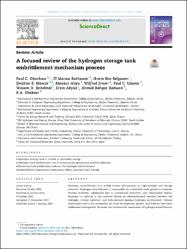| dc.contributor.author | Okonkwo, Paul | |
| dc.contributor.author | Barhoumi, El Manaa | |
| dc.contributor.author | Ben Belgacem, Ikram | |
| dc.contributor.author | Mansir, Ibrahim B. | |
| dc.contributor.author | Aliyu, Mansur | |
| dc.contributor.author | Emori, Wilfred | |
| dc.contributor.author | Uzoma, Paul C. | |
| dc.contributor.author | Beitelmal, Wesam H. | |
| dc.contributor.author | Akyüz, Ersin | |
| dc.contributor.author | Radwan, Ahmed Bahgat | |
| dc.date.accessioned | 2024-08-29T07:19:14Z | |
| dc.date.available | 2024-08-29T07:19:14Z | |
| dc.date.issued | 2023 | en_US |
| dc.identifier.issn | 0360-3199 / 1879-3487 | |
| dc.identifier.uri | https://doi.org/10.1016/j.ijhydene.2022.12.252 | |
| dc.identifier.uri | https://hdl.handle.net/20.500.12462/15086 | |
| dc.description | Akyüz, Ersin (Balikesir Author) | en_US |
| dc.description.abstract | Hydrogen embrittlement is a widely known phenomenon in high-strength and storage materials. Hydrogen embrittlement is responsible for subcritical crack growth in material, fracture initiation, subsequent loss in mechanical properties, and catastrophic failure. Hydrogen is induced in the material during an electrochemical reaction between the hydrogen, storage materials, and high-pressure gaseous hydrogen environment. Various mechanisms which are responsible for crack development, growth, and fracture have been deliberated and reported. However, the fundamental mechanism of hydrogen embrittlement remains unclear. Several techniques such as linearly increasing stress test techniques (LIST), constant extension rate test (CERT) and slow strain rate testing (SSRT), thermal desorption spectroscopy (TDS), permeation testing (PT), scanning electron microscopy (SEM), and transmission electron microscopy (TEM) have been utilized to determine the amount of hydrogen diffused and available in the hydrogen storage material. The review intends to categorize and provide a clear understanding of the degradation mechanism that occurs during hydrogen embrittlement. The improvement in mitigating the hydrogen embrittle-ment degradation as a function of modifying the structure and surfaces of the material is established. Prospects for addressing hydrogen embrittlement degradation through further experimental and numerical research are suggested. Lastly, this paper through recommen-dation endeavors to prevent hydrogen storage tank degradation and reduces high costs associated with the replacement of the component in renewable energy applications. (c) 2022 Hydrogen Energy Publications LLC. Published by Elsevier Ltd. All rights reserved. | en_US |
| dc.description.sponsorship | Prince Sattam bin Abdulaziz University PSAU/2023/R/1444 | en_US |
| dc.language.iso | eng | en_US |
| dc.publisher | Pergamon-Elsevier Science Ltd | en_US |
| dc.relation.isversionof | 10.1016/j.ijhydene.2022.12.252 | en_US |
| dc.rights | info:eu-repo/semantics/embargoedAccess | en_US |
| dc.subject | Degradation | en_US |
| dc.subject | Hydrogen Embrittlement | en_US |
| dc.subject | Storage Tank | en_US |
| dc.subject | Hydrogen Diffusion | en_US |
| dc.subject | Materials | en_US |
| dc.title | A focused review of the hydrogen storage tank embrittlement mechanism process | en_US |
| dc.type | review | en_US |
| dc.relation.journal | International Journal of Hydrogen Energy | en_US |
| dc.contributor.department | Mühendislik Fakültesi | en_US |
| dc.contributor.authorID | 0000-0001-8803-7729 | en_US |
| dc.contributor.authorID | 0000-0003-0028-3090 | en_US |
| dc.contributor.authorID | 0000-0001-9786-3221 | en_US |
| dc.contributor.authorID | 0000-0002-0644-8741 | en_US |
| dc.contributor.authorID | 0000-0003-1115-3590 | en_US |
| dc.identifier.volume | 48 | en_US |
| dc.identifier.issue | 35 | en_US |
| dc.identifier.startpage | 12935 | en_US |
| dc.identifier.endpage | 12948 | en_US |
| dc.relation.publicationcategory | Diğer | en_US |


















